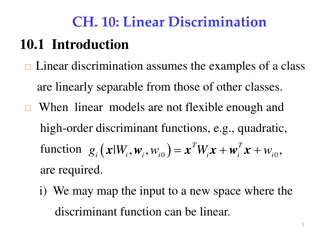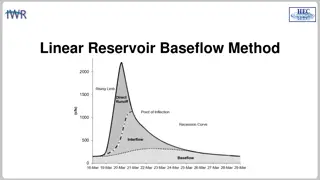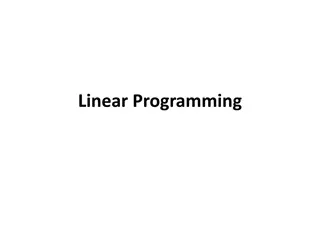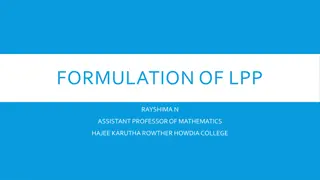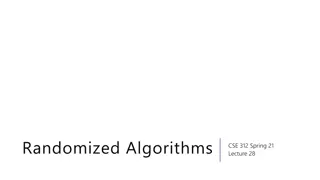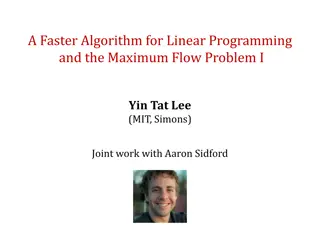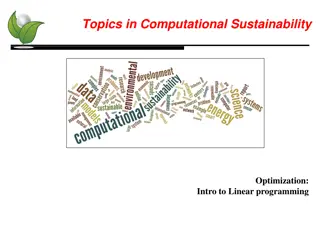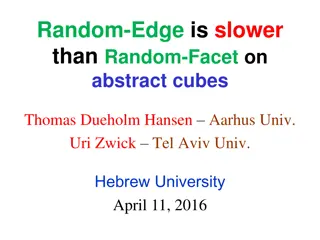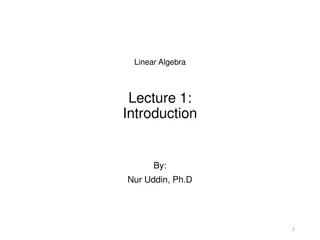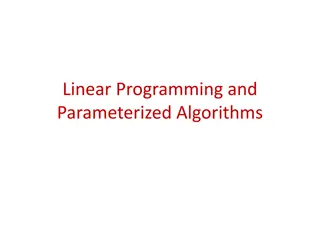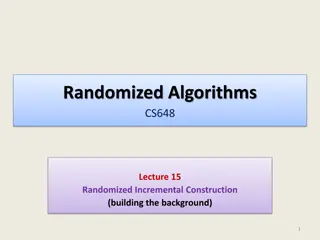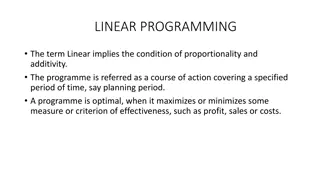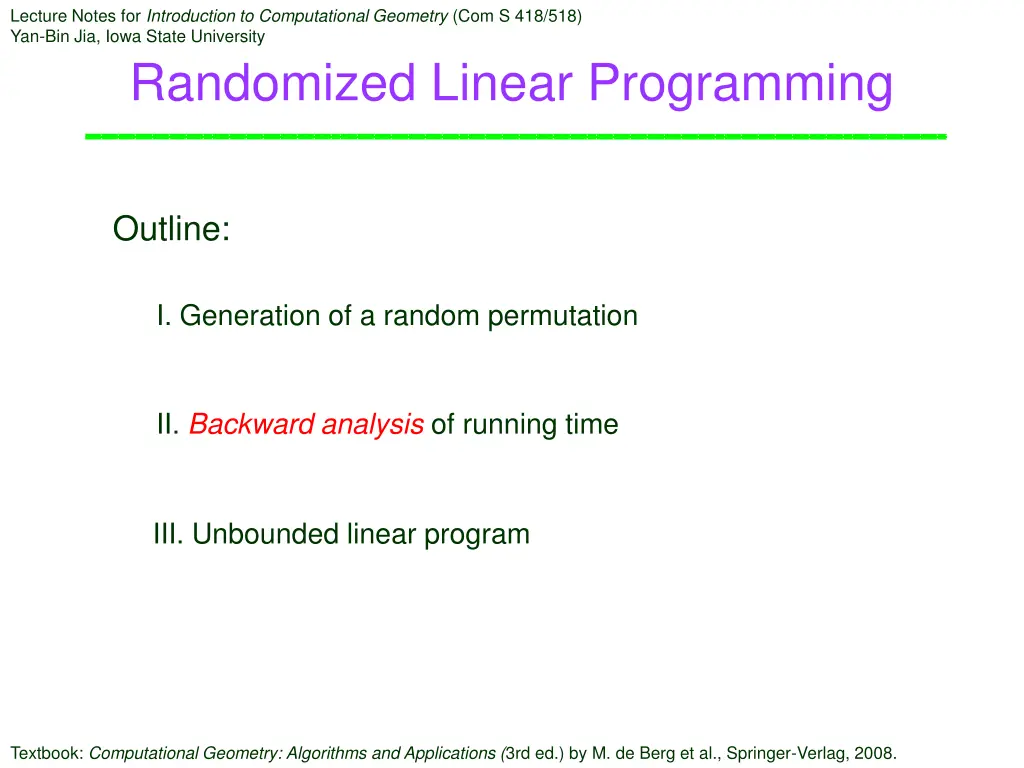
Computational Geometry Lecture Notes and Randomized Linear Programming Overview
Explore lecture notes on computational geometry and randomized linear programming, covering topics like random permutations, backward analysis of running time, and algorithm modifications. Learn about avoiding worst-case scenarios, generating random permutations, and analyzing the running time of randomized algorithms. Discover how to handle infeasible scenarios and unbounded LP problems, along with techniques for efficient solution strategies.
Download Presentation

Please find below an Image/Link to download the presentation.
The content on the website is provided AS IS for your information and personal use only. It may not be sold, licensed, or shared on other websites without obtaining consent from the author. If you encounter any issues during the download, it is possible that the publisher has removed the file from their server.
You are allowed to download the files provided on this website for personal or commercial use, subject to the condition that they are used lawfully. All files are the property of their respective owners.
The content on the website is provided AS IS for your information and personal use only. It may not be sold, licensed, or shared on other websites without obtaining consent from the author.
E N D
Presentation Transcript
Lecture Notes for Introduction to Computational Geometry (Com S 418/518) Yan-Bin Jia, Iowa State University Randomized Linear Programming Point Outline: I. Generation of a random permutation II. Backward analysis of running time III. Unbounded linear program Textbook: Computational Geometry: Algorithms and Applications (3rd ed.) by M. de Berg et al., Springer-Verlag, 2008.
How to Avoid Worst Case? Pick a random ordering of the set ? of half-planes. ? 1 ? 2 Bad order still leads to ?(?2). 6 5 4 ?? 3 Most orders lead to a faster algorithm. ?6 ?5 ?4 ?3 ?2
Algorithm Modification 1, 2 certificate half-planes ?2 ?1 ?2 generate a random permutation of 3, 4, , ? for ? 3 to ? do if ?? 1 ? then ?? ?? 1 else ?? point ? on ?? that maximizes ? subject to 1, 2, , ? 1 if ? does not exist then LP is infeasible return ??
I. Random Permutation Array ?[1..?] 1 ? ? ? for ? ? down to 2 do ? RANDOM(?) ?[?] // returns a random integer between //1 and ? under uniform distribution. ?[?] ?(?)
How Does It Work? 4 RANDOM 4 = 2 3 1 2 RANDOM 3 =1 1 4 2 3 RANDOM 2 = 2 3 4 2 1 Every permutation is equally likely to be generated. 4 2 3 1 Why?
II. Run Time Analysis The LP algorithm is randomized. Its running time depends on random choices. How to analyze the running time? ? 2 ! permutations of 3, 4, , ? Average over all of them (expected time).
Start of Analysis if UNBOUNDEDLP reports that LP is infeasible then return // does not detect all infeasible scenarios else if LP is unbounded // to be discussed then return a ray along which it is unbounded else 1, 2 certificate half-planes ?2 ?1 ?2 generate a random permutation of 3, 4, , ? for ? 3 to ? do if ?? 1 ? then ?? ?? 1 else ?? point ? on ?? that maximizes ? subject to 1, 2, , ? 1 if ? does not exist then LP is infeasible return ?? UNBOUNDEDLP takes time ?(?) to be shown. Random permutation takes time ?(?). Add a half-plane. ?(1) if the optimal vertex does not change. ?(?) for solving a 1D LP otherwise. Bounding the average time for solving all 1D LPs.
Random Variable For stage ? 3 5 4 0 if ?? 1 ? ?4= ?5 1 ??= 2 3 5 6 4 1 otherwise ?6 ?6 ?5 1 2
Expected Time Total time over all half-planes 3, 4, , ?. ? ?(?) ?? ?=3 Expected total time: How to determine? ? ? ? ? ? ?? = ? ? ?(??) ?=3 ?=3 Probability that ?? 1 ? Are we going to exhaust all (topologically) different scenarios of half-plane additions and then assign each a possibility? Too complicated even if possible!
Backward Analysis Look at the algorithm backwards. Assume it has finished with the optimal vertex ?? found. ??is a vertex of ??= ?=1 ? ? ?? 1is from ??after removing ?. Suppose that the optimal point changes at stage ?. ?defines ?? ? a random element of { 1, 2, , ?} Pr{ ?is one of ?? s only two defining half-planes} 2 ? ? ?? ?
2 ? ? Why > 2 half-planes may have boundary lines through ??. ??already existed before addition of ?. (?? 1 ?? and ?? 1 ?) ? ? removal of ? does not affect the vertex. ?
Stage ? To bound ? ??, we fix the set ?? of first ? half-planes. Think one step backward. Pr(computing a new optimal vertex when adding ?) = Pr(the optimal vertex changes when removing a half-plane from ??) 2 ? Thus, ?(??) 2 ?
Expected Running Time for solving an LP is ? ? ?(?) 2 2? ? = ? ? ?=3 ?=3 = ?(?) Theorem 2D linear programming with ? constraints is solvable in ?(?) expected time and ?(?) storage.
III. Unbounded Linear Program UNBOUNDEDLP(?,?) yields a ray ? = ? if LP is unbounded 1, 2 ? such that ({ 1, 2},?) is bounded, otherwise. certificate half-plane ??: outward normal ?? ? ?? [0,?] ?? ?? ?
Minimum Angle ??= min 1 ? ??? ? ?? ? ?
Initial Slab ????= { ? ? | ??= ??} ????= { ? ? | ??= ??} ? ? Parallel boundary lines. ? Compute ???? ? = (???? ????) ???? ?(?) time ? = LP infeasible!
Non-Empty Slab (? ) ? bounded by some line ?? with ? ????. Assumption At least one half-plane not in ???? or ????. Ray ??= ?? ? where 1 ? ?, ? ???? ???? ? ?? ? ?? ?
Case 1: Unbounded LP ??= ?? ? unbounded in ? for all 1 ? ?, ? ???? ????. All ?? lie on ??. ?? is a ray unbounded in ?. ? ???? ???? ? ???? ???? Ray intersection in ?(?) time. ?? ? ???? ???? ?? Lemma 1 If ??= ?? ? is unbounded in ? for every ? ???? ????, then ?,? is unbounded along a ray contained in ?? which can be computed in ? ? time. ? ??
Case 2: Bounded LP Boundary line ?? with ? ???? bounds ?. Lemma 2 If ??= ?? ? is bounded in ? for some ? ???? ????, 1 ? ?, then LP ?, ?,? is bounded. Proof By contradiction. Assume that LP ?, ?,? is unbounded. ?? ? ?? ?? bounded in ? ?? ? = ?? ? must be unbounded. ?? ? ? ? ? ? must be in the region ? between ?? and ? (? ? &? ?) that is contained in ?. ?? ? ??
Contradiction to Choice of ? ? in the region between ? and ??. rotate each vector counterclockwise by ? ?, ? , ?? becomes ??, ?, ??, respectively. 2. ?? must be in the region between ? and ?? (note ?? ??). ?? ? ?? ??< ??= min 1 ? ??? Contradiction! ?? ? ?? ?? ?? ? ? ?? ? ?? ?? ? ? (? ? & ? ?) ? ?? ?? ?
UNBOUNDEDLP(?, ?) Compute??for all 1 ? ? Choose ? such that??= min 1 ? ??? ???? { ? ? | ??= ??} ???? { ? ? | ??= ??} ? ? (???? ????) ? (???? ????) if ? = then LP(?,?) is infeasible else ? ????that bounds ? if ??= ?? ?bounded for some ? ? then LP(?,?) is bounded // it may still be infeasible else LP(?,?) is unbounded along the ray ?? ( ?)
Correctness and Running Time Lemma 3 UNBOUNDEDLP(?, ?) decides whether a 2D LP with ? constrains is unbounded in ?(?) time, and if so, returns a ray in the feasible region unbounded in ?.

